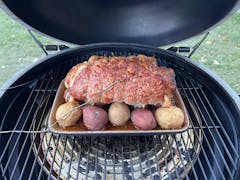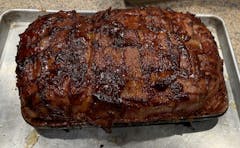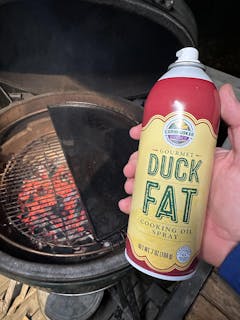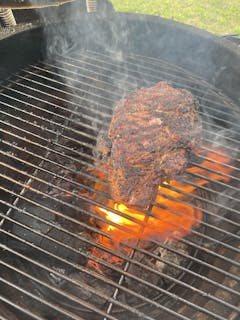Discover the Perfect Gas Grill for Every Occasion at Kookio
Experience the joy of outdoor cooking with Kookio's wide range of gas grills, meticulously designed to meet the needs of every grilling enthusiast. Whether you're looking for freestanding gas grills, built-in setups, or the convenience of portable units, our collection includes only the best gas BBQ grills on the market.
Freestanding Gas Grills:
Our selection of freestanding gas grills offers unparalleled flexibility and convenience, making them a top choice for both novices and seasoned grill masters. Freestanding gas grills are perfect for those who appreciate the ease of mobility and storage. These grills stand out as some of the best gas BBQ grills due to their versatility and user-friendly features.
Natural Gas Grills:
For those who prefer a permanent fixture in their outdoor cooking space, our natural gas grills offer reliability and cost-effective operation. Connect a natural gas grill directly to your home’s gas supply for endless grilling. Our natural gas grills are considered some of the best gas BBQ grills for their efficiency and consistency in cooking.
Portable Gas Grills:
Take the party anywhere with our portable gas grills. Compact and easy to transport, these grills embody the freedom of grilling on the go while maintaining the high standards of the best gas BBQ grills. Our portable gas grills are ideal for tailgating, camping, or any outdoor gathering, ensuring you enjoy the full benefits of a natural gas grill wherever you are.
Best Gas BBQ Grills:
At Kookio, we pride ourselves on offering the best gas BBQ grills in every category. From freestanding gas grills that combine flexibility with power, to natural gas grills that offer convenience and longevity, our grills are carefully selected to enhance your grilling experience. Each model is built to perform, featuring the best in grilling technology and design.
Explore our expansive selection of the best gas BBQ grills, including top-of-the-line freestanding gas grills and premium natural gas grills. Whether you're upgrading your outdoor kitchen or starting fresh, Kookio has the perfect gas grill to make your culinary creations come alive. Shop with us today and find out why our freestanding gas grills, natural gas grills, and portable options are celebrated by grill enthusiasts everywhere.
FAQ
Gas Grill Product Questions
Natural gas or propane grills - which is better?
The choice between natural gas or propane grills really comes down to what suits your grilling needs and location. Natural gas grills offer the convenience of a continuous supply and are generally cheaper to run because they connect directly to your home’s gas line. Propane grills, however, are preferred for their portability since they can be set up anywhere with a propane tank, making them ideal for locations without a natural gas hookup.
What are the benefits of a natural gas grill?
Natural gas grills are praised for several key benefits:
- Convenience: With a direct connection to your home’s gas supply, there’s no need to refill propane tanks.
- Cost-Effectiveness: Natural gas generally costs less than propane, offering savings over time.
- Environmental Impact: Natural gas burns cleaner than propane, producing fewer emissions and contributing to a smaller environmental footprint.
How long does a propane tank last on a grill?
The lifespan of a propane tank when grilling varies based on several factors:
- Tank Size: A standard 20-pound tank typically offers about 18-20 hours of grilling.
- Heat Settings: Higher cooking temperatures consume more gas.
- Frequency of Use: Frequent use will deplete a tank quicker than occasional grilling. It’s wise to keep an extra propane tank handy to ensure you never run out mid-BBQ.
What are the disadvantages of natural gas grills?
While natural gas grills are convenient, they have some drawbacks:
- Installation Requirements: Setting up a natural gas grill requires a gas line, which can be costly and requires professional installation.
- Portability: These grills are fixed to one location, limiting flexibility compared to portable propane grills.
- Safety Concerns: Improper installation can lead to gas leaks, posing serious risks.
- Heating Efficiency: Some users find that natural gas grills don’t reach the high temperatures of propane grills, which can affect cooking outcomes.
How do I know if my grill is natural gas?
To determine if your grill is powered by natural gas, check if it is connected to a permanent gas line. Additionally, consult your grill’s manual or look for labels on the grill itself that specify the fuel type. Natural gas grills usually have specific connectors and regulators different from those on propane grills.
Can I convert my gas grill to natural gas?
Yes, it is possible to convert a propane grill to natural gas by using a conversion kit designed for your specific model. Ensure the grill is compatible with natural gas and follow the manufacturer's instructions or hire a professional to ensure safety and proper installation.
Which brands sell top-rated gas grills?
Brands like Weber, Napoleon, or Monument Grills are renowned for their high-quality gas grills. These brands offer a variety of models that cater to different grilling needs and preferences, from basic grills to advanced units with extensive features.
How long do natural gas grills last?
The longevity of a natural gas grill depends on the quality of the grill, maintenance practices, and frequency of use. Typically, a well-maintained natural gas grill can last between 5 to 15 years.
Can you use LPG on a natural gas BBQ?
It is not advisable to use propane (LPG) in a natural gas BBQ as the two gases require different pressures and equipment. To switch from one gas to another, you must use a conversion kit appropriate for your BBQ model. Always ensure conversions are done safely, preferably by a professional.
Gas Grill Cooking Questions
How to Smoke on an Outdoor Gas Grill?
Smoking on a gas grill requires indirect heat and wood smoke. Begin by soaking your wood chips in water for at least 30 minutes before you plan to start grilling. This prevents them from burning up too quickly. Drain the chips and place them in a smoker box or wrap them in a foil packet with holes poked in the top to release the smoke. Place the smoker box or foil packet directly over one of the burners. Turn on the grill, setting it to a low heat to create a slow, steady smoke. Place your food on the grill away from the direct heat source and close the lid to trap the smoke. Maintain a consistent temperature by adjusting the burners as needed. This method infuses your food with a rich, smoky flavor typical of traditional BBQ.
Where Does the Smoke Box Go in a Gas BBQ Grill?
The placement of the smoke box is crucial for effective smoking on a gas grill. It should be positioned directly on top of the burner that will be turned on during the smoking process. If your grill has a dedicated smoker box drawer or spot, use it; otherwise, place the smoker box or foil packet on the grates over one of the burners at one side of the grill. This setup allows the wood chips to smolder and produce smoke that will envelop the food, giving it that desired smoky taste.
How to Grill Steak on a Gas Grill?
Grilling the perfect steak on a gas grill involves careful heat management and timing. Start by preheating your grill on high for about 10-15 minutes to get a good sear on the steak. Lightly oil the steak and season it with salt, pepper, and any other spices you prefer. Place the steak on the grill and let it sear undisturbed for about 4-5 minutes, depending on its thickness. Flip the steak once to cook the other side for another 4-5 minutes. For precision cooking, use a meat thermometer to check for doneness: 135°F for medium-rare, 145°F for medium, and over 150°F for well-done. Let the steak rest for a few minutes off the grill before serving to allow the juices to redistribute.
How to Grill Chicken Breast on a Propane Gas Grill?
For juicy grilled chicken breasts, start by preheating your grill to a medium-high temperature. Brush the chicken breasts with oil and season with salt, pepper, and your choice of herbs or spices. Place the chicken on the hot grill and close the lid. Grill the chicken for 6-8 minutes on one side, then flip and grill for another 5-7 minutes on the other side. The key to perfect grilled chicken is ensuring the internal temperature reaches 165°F. Allow the chicken to rest for a few minutes before slicing to keep the juices locked in.
How to Grill Burgers on a Gas Grill?
Grilling burgers on a gas grill is straightforward. Preheat the grill to high heat. Shape your ground beef into patties and season them with salt and pepper. Place the patties on the grill and cook for about 4-5 minutes on each side. Flipping should be done once to ensure even cooking and to avoid losing juices. Check that the internal temperature of the patties reaches 160°F for safety. Serve your burgers with a choice of toppings and buns.
How to Grill Chicken Thighs on a Gas Grill?
Chicken thighs are flavorful and benefit from medium-high heat grilling. Season the thighs as desired and preheat your grill. Place the thighs skin-side down on the grill and cook for about 5-7 minutes. Flip the thighs and continue to cook for another 5-7 minutes or until the internal temperature reaches 165°F. Rest the chicken briefly before serving to ensure it remains juicy and delicious.
How to Grill Salmon on a Gas Grill?
Grilling salmon requires attention to prevent overcooking. Preheat the grill to medium-high heat. Brush the salmon fillets with oil and season with salt and pepper. Place the salmon skin-side down on the grill and close the lid. Cook for about 5-6 minutes per side, or until the salmon is opaque and flakes easily with a fork. Serve immediately with lemon wedges and enjoy the natural flavors of grilled salmon.
Gas Grill Cleaning & Safety Questions
Are Natural Gas Grills Considered Safe?
Natural gas grills are safe when properly installed and maintained. Key safety measures include ensuring proper ventilation to prevent carbon monoxide buildup and conducting regular inspections for gas leaks and proper functionality. It’s crucial to keep the grill in an open area away from any structures to ensure safety.
How Safe Are Propane Gas Grills?
Propane gas grills are generally safe if used according to the manufacturer's guidelines. Safety precautions include placing the grill well away from flammable materials and regularly checking for leaks with a soapy water solution. Always supervise the grill when in use to prevent accidents.
Steps to Safely Remove a Propane Tank from a Grill
To safely remove a propane tank:
- Ensure the grill and the tank valve are both turned off.
- Disconnect the regulator by unscrewing the coupling nut.
- Carefully lift the tank away from the grill.
- Store the tank upright in a cool, dry place, away from direct sunlight.
Recommended Distance for a Natural Gas Grill from the House
A natural gas grill should be positioned at least 10 feet away from the house or any other structures or flammable materials. This distance helps to minimize the risk of fire spreading to the house in the event of a flare-up or other fire-related incidents.
Is It Safe to Leave a Natural Gas Grill Outside During Winter?
Leaving a natural gas grill outside in winter is not recommended. Exposure to extreme cold and moisture can damage the grill’s components and increase the risk of operational failures. It's best to store the grill in a covered, dry area during the off-season.
Comprehensive Guide to Cleaning a Gas Grill
To thoroughly clean a gas grill:
- Turn off and disconnect the gas supply.
- Remove grates and burner covers, soaking them in soapy water.
- Clean grates and covers with a grill brush or scrubbing pad.
- Scrape off debris from the inside of the grill using a putty knife or scraper.
- Clean the burners with a wire brush to ensure they are free of blockages.
- Wipe the exterior surfaces with a suitable cleaner.
- Reassemble the grill and run it on high heat for about 15 minutes to burn off any residue.
How to Clean Gas Grill Burners Effectively
To clean gas grill burners properly:
- Remove any large debris manually.
- Detach the burners and soak them in soapy water if they are removable.
- Scrub the burners with a wire brush or stiff scrubber.
- Rinse thoroughly with clean water.
- Dry completely before reassembling the grill.
Can I Use a Natural Gas Grill Indoors?
Using a natural gas grill indoors is hazardous due to the risk of carbon monoxide poisoning and the potential accumulation of explosive gases. Always use natural gas grills outdoors in well-ventilated areas.
Why Are Natural Gas Grills Scarce in California Stores?
The limited availability of natural gas grills in California can be attributed to:
- Lower regional availability of natural gas.
- Reduced consumer demand compared to propane grills.
- Strict local regulations regarding gas appliance installations and emissions.
What Are the Risks of Using Propane in a Natural Gas Grill?
Using propane in a natural gas grill is unsafe and can lead to equipment damage or personal injury. Propane operates at a higher pressure than natural gas, which can cause overpressure in the gas lines or burners, leading to a risk of explosion or fire.
Best Practices for Storing Gas Grills
Store your gas grill in a shaded, dry area such as a shed or garage. Cover the grill with a breathable grill cover to protect it from the elements and reduce the likelihood of rust and dirt buildup. Ensure the propane tank is disconnected and stored separately in a secure, upright position.
Gas Grill - General Questions
Are Electric Grills Better Than Gas Grills?
Choosing between electric and gas grills depends on your specific needs and preferences. Electric grills are ideal for those with limited outdoor space or for apartment dwellers because they don’t produce flames and typically can be used indoors. They are also easier to maintain. However, gas grills are favored for their ability to reach higher temperatures and impart a traditional smoky flavor to the food, which is highly prized by barbecue enthusiasts. Ultimately, the choice hinges on whether convenience or flavor is your priority.
How to Run a Natural Gas Line for an Outdoor Grill
Running a natural gas line to an outdoor grill should be handled by a professional due to the complexity and safety concerns involved. The process typically involves:
- Planning the route from your main gas supply to your grill’s location, considering the shortest and safest path.
- Installing a gas shutoff valve specifically for the grill.
- Using appropriate materials such as coated stainless steel piping or flexible connectors that comply with local building codes.
- Testing the line for leaks once installed. Always consult with a licensed plumber or a certified gas fitter to ensure the installation meets local safety regulations.
How Long Does a 1 lb Propane Tank Last on a Gas Grill?
A 1 lb propane tank typically lasts about 1.5 to 2 hours when used on a standard gas grill running on medium to high heat. This duration can vary based on the grill’s efficiency, the outside temperature, and the specific settings used while cooking.
How to Buy a Gas Grill
When buying a gas grill, consider the following factors:
- Size and Cooking Area: Match the grill size to the number of people you typically cook for.
- Heat Output: Look for grills with adequate BTUs (British Thermal Units) to ensure efficient cooking but beware of overemphasis on high BTU numbers alone.
- Build Quality: Choose grills with durable materials like stainless steel.
- Features: Consider extras like side burners, rotisserie kits, and built-in thermometers depending on your cooking style.
- Price: Set a budget and compare features within that range. Higher prices often correlate with better build quality and additional features.
- Warranty and Support: Opt for brands with good customer support and warranty terms.
Can You Put Charcoal in a Gas Grill?
It is not recommended to put charcoal in a gas grill. Gas grills are designed for clean burning fuels such as propane or natural gas, and using charcoal could pose a safety risk and damage the grill. Charcoal can obstruct the burner tubes and cause uneven heating or even fires. If you prefer the flavor of charcoal, consider a combo grill that accommodates both gas and charcoal, or use smoker boxes with wood chips on your gas grill for a smoky flavor.







